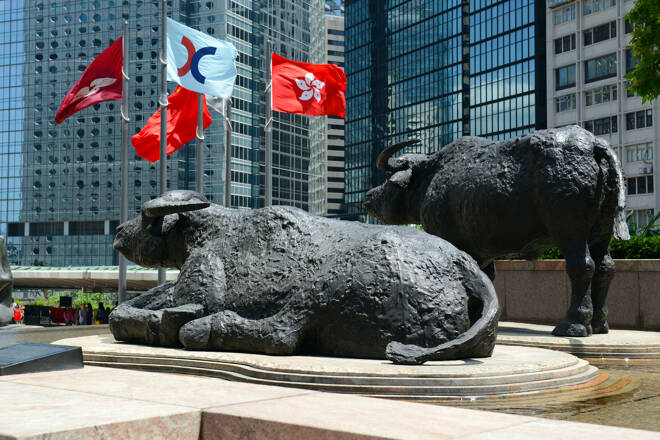Advertisement
Advertisement
Hang Seng Index, ASX 200, Nikkei 225 Index: Fed Fears and China’s Struggles Shape Forecast
By:
With PBoC expected to adjust loan prime rates, the broader forecast for Asian markets intertwines with potential stimulus from Beijing.
Key Insights:
- Hang Seng and broader Asian markets faced challenges on Friday, while the ASX 200 showed resilience.
- Evergrande’s US bankruptcy protection intensifies bearish sentiment toward China.
- PBoC’s anticipated LPR adjustments garner attention, hinting at economic maneuvers.
Friday Overview
It was a mixed end to the week, with the Hang Seng Index and the broader Asian markets continuing to struggle. The ASX 200 avoided negative territory, while the Hang Seng Index and the Nikkei saw red for the third consecutive session.
There were no economic indicators from China to shift investor sentiment. Inflation figures from Japan supported the Bank of Japan’s ultra-loose monetary policy position but failed to provide Nikkei support.
News of Evergrande filing for bankruptcy protection in the US Courts added to the bearish mood toward China.
Market sentiment toward the ailing Chinese economy and bets on a more hawkish Fed monetary policy stance weighed on market risk appetite. US economic indicators from Thursday supported the more hawkish sentiment toward Fed monetary policy. US Jobless claims declined from 250k to 239k versus a forecasted 240k. Philly Fed Manufacturing Index numbers were also bullish.
The Philly Fed Manufacturing Index rose from -13.5 to +12.0 in August. Economists forecast a modest increase to -10.0. Significantly, the Prices Paid Index jumped from +9.50 to +20.80, supporting the bets on a more hawkish Fed policy outlook.
Sentiment Toward China and the Fed Continued to Pressure Riskier Assets
There were no US economic indicators from Friday to set the mood going into the Monday session. China remains a headwind for riskier assets, with investors uncertain whether Beijing has the tools to reboot the ailing economy.
Fed Fear remains a stumbling block after upbeat US economic indicators from last week. This week, the Fed could deliver much-needed forward guidance. The Jackson Hole Symposium and Fed Chair Powell are in the spotlight.
On Friday, the NASDAQ Composite and the S&P 500 ended the day down 0.20% and 0.01%, respectively. The Dow bucked the trend, gaining 0.07%.
This morning, there are no economic indicators from China or the region for investors to consider. However, the PBoC will set the one-year and five-year loan prime rates (LPR), which will need consideration.
Economists expect the PBoC to cut the one and five-year LPRs by 15 basis points to 3.4% and 3.55%, respectively. A larger-than-expected cut should support riskier assets.
However, investors should also monitor the news wires for stimulus chatter from Beijing.
ASX 200
The ASX 200 gained a modest 0.03% on Friday but ended the week down 2.62% on China jitters. The big-4 banks saw red, while mining stocks provided support.
On Friday, ANZ Group (ANZ) and Westpac Banking Corp (WBC) saw losses of 0.41% and 0.42%, respectively. The Commonwealth Bank of Australia (CBA) and The National Australia Bank (NAB) declined by 0.60% and 0.47%, respectively. Concerns over China contagion weighed on banking stocks.
Mining stocks had a bullish session, with a softer dollar and dip buyers providing support. Rio Tinto (RIO) and BHP Group Ltd (BHP) ended the day with gains of 0.88% and 1.35%, respectively. Fortescue Metals Group (FMG) and Newcrest Mining (NCM) rose by 0.99% and 0.52%, respectively.
However, oil stocks struggled despite a bounce in oil prices on Friday. Woodside Energy Group (WDS) and Santos Ltd (STO) ended the day with losses of 0.16% and 0.89%, respectively.
Hang Seng Index
The Hang Seng Index fell into bear market territory on Friday, tumbling by 2.05% to end the week down 5.89%. Investors responded to the news of Evergrande filing for bankruptcy amidst increasing concerns over the Chinese economy.
Considering the main Index components, Tencent Holdings Ltd (HK:0700) and Alibaba Group Holding Ltd (HK:9988) ended the day with losses of 2.34% and 3.44%, respectively.
Bank stocks also had a bearish session. HSBC Holdings PLC declined by 1.10%. China Construction Bank (HK: 0939) and The Industrial and Commercial Bank of China (HK:1398) saw losses of 0.29% and 0.49%, respectively.
CNOOC (HK: 0883) gained 0.16% on rising oil prices.
Nikkei 225
(For reference purposes only)
The Nikkei 225 fell by 0.55% on Friday. A weaker USD/JPY countered softer core inflation numbers to test buyer appetite. Japan’s annual inflation rate held steady at 3.3%, while core inflation softened from 3.3% to 3.1% in July. The latest inflation numbers remained above the government forecasts for this fiscal year. Japan’s government forecasted an inflation rate of 2.6% in July.
The banks had a bearish session. Sumitomo Mitsui Financial Group (8316) and Mitsubishi UFJ Financial Group saw losses of 0.53% and 0.41%, respectively.
Looking at the main components, Fast Retailing Co (9983) and Sony Corp (6758) ended the session down 1.15% and 0.95%, respectively. Fast Retailing has significant exposure to China through more than 900 Uniqlo outlets, with Sony Corp also at the mercy of economic sentiment. KDDI Corp (9433) also saw red, falling by 0.48%.
However, SoftBank Group Corp. (9984) gained 0.22% on the news of acquiring Vision Fund’s stake in Arm. Tokyo Electron Limited (8035) rose by 0.68%.
Check out our economic calendar for economic events.
About the Author
Bob Masonauthor
With over 28 years of experience in the financial industry, Bob has worked with various global rating agencies and multinational banks. Currently he is covering currencies, commodities, alternative asset classes and global equities, focusing mostly on European and Asian markets.
Advertisement
